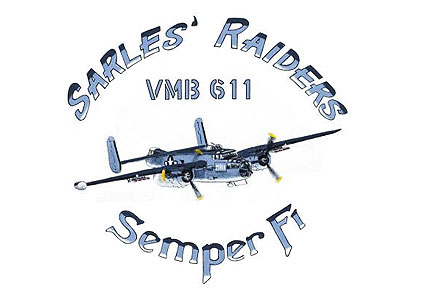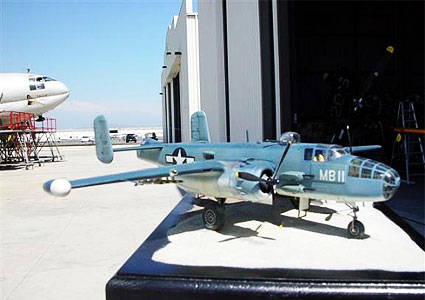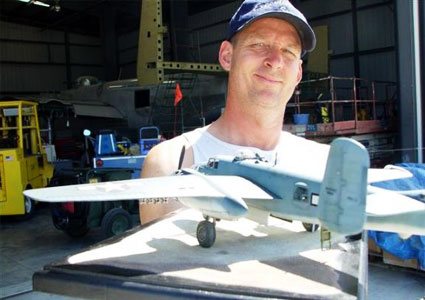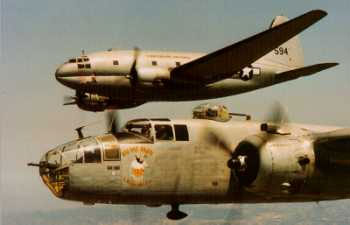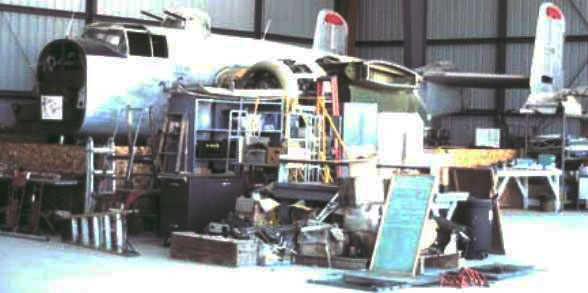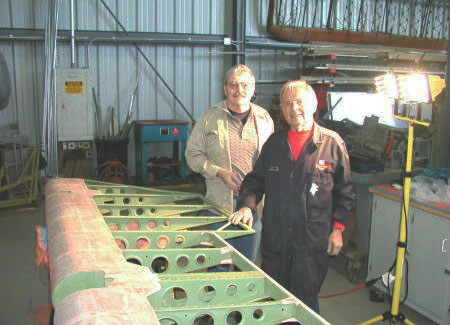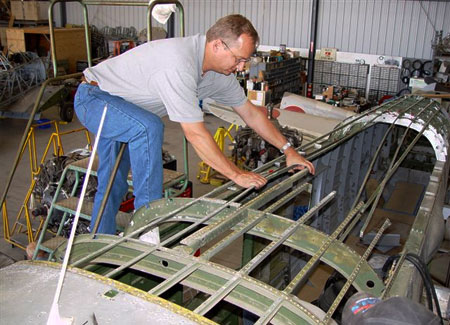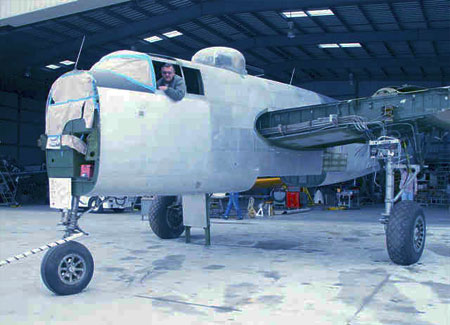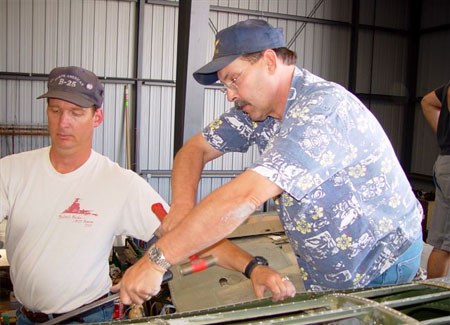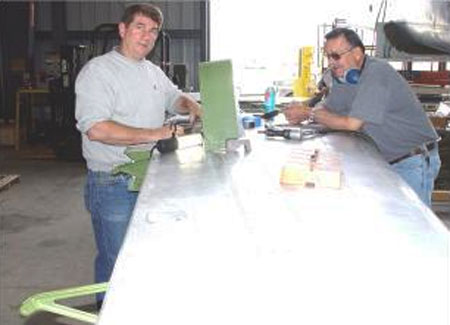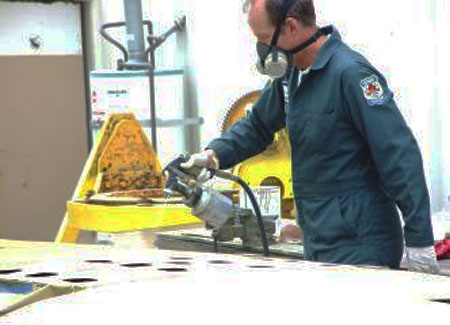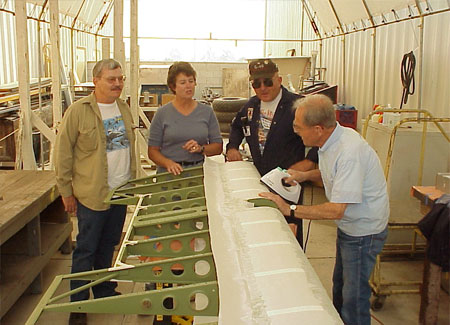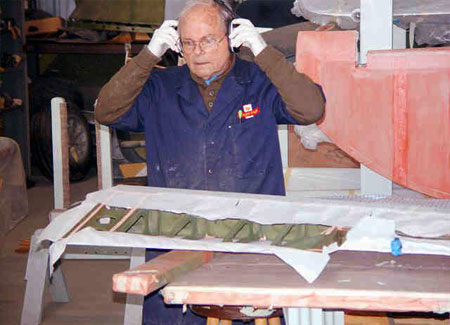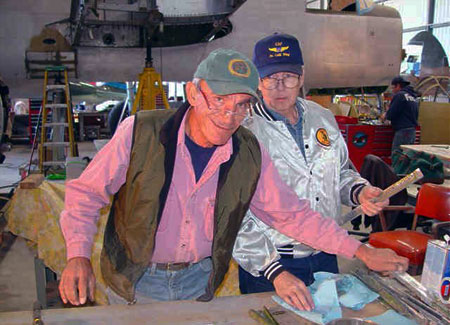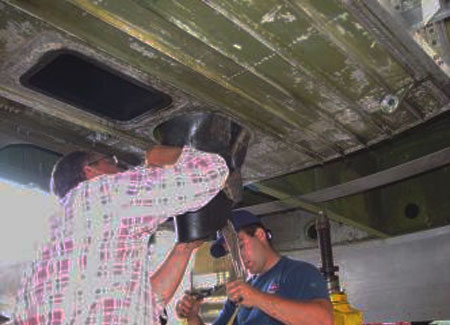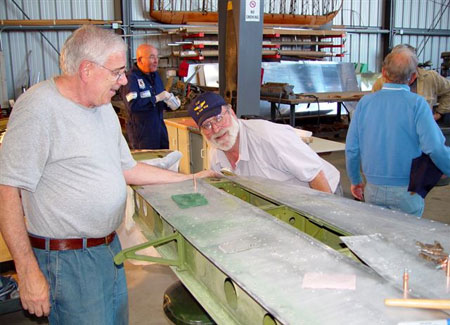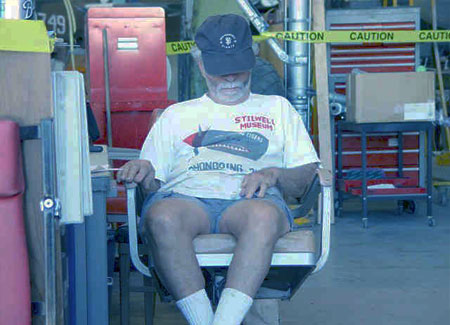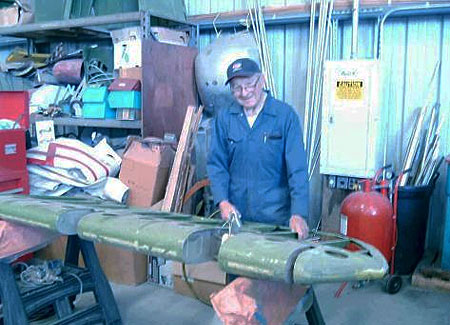© Photo by Dan Newcomb
The Logo for PBJ-1J “Semper Fi,” designed by Thomas Van Stein, a member of the PBJ Restoration Team. Note the markings “MB-11.
A model of PBJ-1J in the colors of Marine Corps Squadron MB-11.
This is what the CAF, SoCAWing’s PBJ Restoration Team wants their plane to look like when the restoration is complete.The model is patterned after the plane that David Fish’s dad flew in when lost on Mindanao. He was part of Sarles’ Raiders – VMB 611 – USMC. He was flying MB 11 when lost.
The model will be shown in a display case near the actual PBJ Restoration
site in the Restoration
Thomas Van Stein, our resident aviation artist, and a member of the PBJ
Restoration Team, with the model he ordered.The tri-color paint scheme includes:
Non-Specular Sea Blue on top; Intermediate Blue on sides; and Camouflage Grey on the bottom. The model is 1/48 scale, and was built by our wing’s Master Model Builder, Col. Joe Nassi.
Thanks to Thomas Van Stein for help with the above text.
Check on this video by Restoration Team member Dan Newcomb covering six years of PBJ-1J restoration. Be sure to have your sound “on.”
Visit Dan Newcomb’s PBJ Site on Warbird Information Exchange’s website
Solo Flight for History
Last remaining aviation relic gets full restoration, national adoration
By James Glover II, jglover@VenturaCountyStar.com June 12, 2006
At the Commemorative Air Force’s repair hangar at Camarillo Airport, the clanking of tools fills the air. All around are antique military aircraft in various stages of repair. At the far end of this hangar, there’s a plane bigger than the others — a 1944 B-25/PBJ Mitchell bomber.
There are many B-25 Mitchells in museums and flying in air shows around the world, but the PBJ model, a B-25 Mitchell owned by the Navy and flown by Marines, is a whole different story.
“This is the only one that’s left,” said Dan Newcomb, a crew member working on the plane. He researched and found that only eight were released to civilian owners. “The rest of them are crashed, destroyed or unaccounted for,” he said of the other seven.
The repair crew — about 12 men who share a passion for aviation history and mechanical things — realized how rare the plane was and scrapped their original plans to model it after an Army B-25. Instead, they decided to restore it to its original condition as a PBJ.
The History Channel is doing a documentary on its restoration and history as a part of the “Save Our History” series. (The tentative date for the show is August 5, 2006).
“It would’ve been a sin to not restore this to a PBJ; you just never see them,” Newcomb said. He noted that there are some B-25s painted to look like a PBJ, but none that are original, restored PBJs.
During their research, the team came across David Fish of Camarillo, whose father, 1st Lt. Doit L. Fish USMC, was listed as missing in action in 1945 while flying a PBJ aircraft named MB-11. In 1956, his father’s remains were found aboard the plane, which had been shot down in the Philippines.
David Fish was asked to be a member of the team as the unofficial historian. He jumped at the chance. “I didn’t even know any PBJs still existed, and then to find one right in my backyard, I was very excited about it,” Fish said.
The team decided to restore the aircraft after Fish’s father’s plane, naming it MB-11. “I was very hesitant at first,” Fish said. “In my mind, MB-11 was strewn across the jungle in the Philippines. The plane was gone, and my dad was gone with it.” The more Fish thought about it though, the more sense it made. “I started thinking what a wonderful tribute this would be to my father and the other pilots of MBV-611 (his squadron).”
Copyright © 2006, Ventura County Star. All Rights Reserved. Displayed with permission.
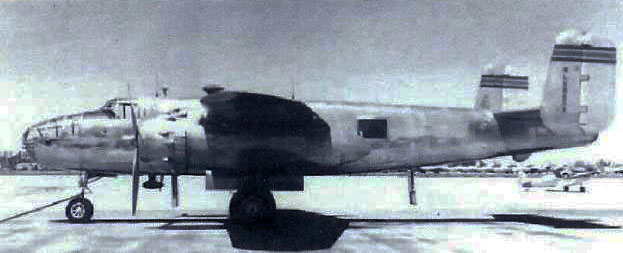
What our #N5865V looked like many years ago.
B-25/ PBJ-1J #N5865V Restoration History
by Marc Russell, Team Leader, PBJ-1J Restoration Team
N5865V, a Navy version (PBJ-1J) of the B-25, is the most ambitious project that the Southern California Wing has ever undertaken. Our wing took over this restoration project in 1993 after many years of neglect and sitting. To exacerbate the situation, this aircraft received many modifications during the years it was in private ownership, modifications that often left this aircraft’s structural integrity in doubt..
Our intention is divided into two phases. The first is to rebuild this aircraft into a safe, reliable and interesting aircraft that can fly to, and be displayed at air shows, operate as a camera platform for aerial filming, training for the military test pilot program and various other opportunities. Once flying, we expect that the revenue she creates will not only pay for the maintenance, but also allow us to outfit her with the type of internal and external equipment she had when in active service.
The B-25/ PBJ family of aircraft is one of the most recognized bomber aircraft from the WWII era. The twin engine, twin tailed aircraft is most famous from the Doolittle Raid that took place on April 18, 1942, where 16 B-25 aircraft launched from the aircraft carrier Hornet and bombed Japan, proving that we could take the war to the enemy.
Production of the Mitchell ran from 1940 through 1945, with more than 11,000 produced. Model designations went from B25A through B-25J, and included basic bomber, gun ship, and a version that mounted a 75mm M4 cannon in the nose. Other armament included up to 14 machine guns, not to mention a payload of over 3000 pounds of bombs. Unfortunately, there are only about 35 flying examples of this aircraft remaining, and ours is the only true PBJ still in existence.
Years have already been spent on this restoration, and we still have a few years more work prior to the first post restoration flight. Between corrosion and the modifications this aircraft received while in private ownership, we have had to do a great deal of reworking, planning and parts fabrication. There has not been a single area that has not required attention.
N5965V was flown into Camarillo airport after a week of maintenance and testing. Once here, we started disassembly. Outboard wing sections were removed, as well as the engines and propellers. Hydraulic components, the 10 fuel tanks and two oil tanks, hydraulic, oil, and fuel plumbing also came out. Structures were built to hold the aircraft solidly in position, and then we started restoration activities.
The inboard section of the left wing was the first area of the aircraft to be tackled. Large amounts of corrosion we apparent and required a near complete disassembly of this section. Each part removed was cleaned and inspected, and when able, was reused.
Unfortunately, many parts, including the main rib and the upper angle that attaches the inboard and outboard wing sections, had to be replaced. Although we do manufacture many of the replacement parts, some are beyond our capability and are built under contract. This has been extremely expensive and has consumed much of our budget.
The bomb bay received a great deal of time and energy as well. Many parts of the original aircraft had been removed for modifications to a corporate and test aircraft. Two kits, provided by AeroTrader of Chino, California were installed, and the bomb bay is now nearly complete. The first kit added strength to the area where the top of the wing attaches to the fuselage. The other kit replaced a barrier that sealed the bomb bay compartment from the crew area and allowed for a crawl space connecting the forward fuselage to the rear. This had been completely removed when the aircraft was in corporate ownership. The only remaining components to be added to this aircraft are the bomb bay racks that were used to release the bombs. These also are used to add structure to this area.
Currently, our efforts are focused on the area behind the bomb bay. This area also received many modifications for the corporate configuration. At some time in the past, much of the right side was removed and modified to accept a fold out stairway. Another hole was cut in the bottom left side of the fuselage and then patched. The original hatch for entry and exit was still installed, but moved aft about 20 inches and was now missing many parts. The floor had been removed and replaced with plywood.
The ceiling structure had many patches and modifications due to the installation of the fold out stairway. Most of the control cables had been rerouted. We removed the entire belly section between the bomb bay and the start of the tail surface and built all new bulkheads, stringers and skins. The hatch area was completely rebuilt, including all cabling and pulleys to open and jettison the hatch door. We have built and installed all new floor panels. The air-stair has been removed along with all of the other modifications associated with it. A new section of longeron, a major component of the structure, had to be built under contract.
After the belly was completed, we started reworking the right side structure. We found that the forward area was in satisfactory condition but the aft section required total replacement. Many of the original formers had received modifications and were rebuilt from scratch. Most of the stringers are new as are the skins. We also found that a major structural component on the upper aft area of this section had a three inch hole caused by corrosion that required special fabrication.
The roof of this area was also in poor shape. Our original plan was to only replace what was really necessary, but as we started to remove the sections that were visibly damaged, we found more and more corrosion. The end result is that this entire area is also being rebuilt from scratch.
While one team is completing this area, another team has been working on the tail’s control surfaces. A thorough inspection of the horizontal tail has been completed and only minor irregularities were found and reworked. This is known as the achilles heal of the aircraft, so inspection and proper maintenance is extremely important. One of the vertical tail sections was found to have extensive damage and has been repaired. Both elevators and rudders have been inspected and covered with fabric covering just as was originally done.
Once all of this is complete, the tail section will be reinstalled as will all of the cables associated with its operation and locking.
The final area of sheet metal work will be the right inboard wing. This will duplicate of the work already done on the left wing. We will first place the aircraft on jacks and remove the landing gear and all of its components. Then, we will remove the skin from the lower surface of the wing stub to determine the amount of damage. All parts will be inspected and replaced as necessary. This wing has had some restoration work done, but it was never completed.
Both outboard wing sections need repair and are currently located at AeroTrader, awaiting funding. Both engines have been sitting for over 10 years and should be overhauled prior to flight. All fuel and oil tanks are original and need replacing.
Expected Costs:
Outboard Wing sections: $60,000 estimate for both wings from AeroTrader.
Engines (Each): $60,000 for entire overhaul, including components Propellers (Each): $10,000 for inspection and overhaul as required Fuel Tanks – (4 mains and 6 aux tanks): $70,000 for fabrication of new tanks Oil Tanks (2): $ 7,000 for fabrication of new tanks These are only estimates for known needed items. There are many other items that will be replaced such as sheet metal, stringers, nuts, bolts, cables, wire harnesses, instruments, and radios.
Maintenance Team:
Roger D. Ostlund –
Occupation: Retired from Shell Oil Company with 31.5 years of service. Background: Jobs included turbine and large diesel engine overhauls, construction of complete offshore production facilities, including overseas and Gulf of Mexico locations. Also commutes from Bakersfield and active with the CAF for about 1 year.
Dave Fish –
Occupation: Retired GTE Telecommunications Background: Son of US Marine Corps Capt Doit L. Fish, PBJ pilot, Marine Bomber Squadron VMB 611, Killed in Action 30 May 1945, Davao, Philippine Islands. Serving as unofficial “historian,” compiling VMB history and memorabilia for the restoration project and future displays.
Occupation: Captain for United Airlines
Background: Marc has been involved with the PBJ project from the beginning.
Was assigned as one of the team leaders early on and has been involved in all facets of the project. Marc is an A&P mechanic and will assume pilot duties when it is complete.
© Photo by Dan Newcomb.
Our Leader! Working on the stringers on the top side of the fuselage. Lots of man-hours go into cleaning up the metal, oftentimes replacing whole parts, and coating and painting to help prevent corrosion.
Occupation: Retired.
Background: Ken has been working on the project longer than most. He has been involved with other restoration projects in the past and his experience and dedication is invaluable. Ken was trained in the military as a helicopter mechanic.
Ken at the controls on a premature “roll-out” of PBJ-1J “Semper Fi.” With all the work you’ve put into this baby, you deserve to sit in the catbird’s seat, Ken!.
Occupation: Retired.
Background: Dan joined the restoration project in 2003 and has been very active. His experience includes 3 years working for McDonnel Douglas building DC-8 aircraft and he holds a private pilots license. Dan drives from Bakersfield.
Photo courtesy of Dan Newcomb.
Dan (on right – with Thomas Van Stein) – working on “stringers” which make up an essential part of the inside fuselage. Many of these have had to be replaced. Dan is our “Resident Photographer,” and is responsible for all the photos on this page. He is keeping a photographic record of the renovation of PBJ-1J “Semper Fi.”
Occupation: Captain for Atlas Air (747-400 aircraft)
Background: Scott has been a pilot for a number of airlines and is in line to fly the PBJ when restoration is complete. Scott is involved in all facets of the restoration including fabrication and construction. He commutes from Lomita when he isn’t flying all over the world.
© Photo by Dan Newcomb
Scott, on left, with Ken Barger, working on preparing a new “skin” for the aircraft. Scott commutes all the way from Lomita, in between stints as a pilot for Atlas, a contract cargo airline flying 747-400 aircraft to far-flung points on the globe
Thomas Van Stein –
Occupation: Commission Artist
Background: Thomas has been involved in the restoration for a number of years.He has been involved in fabrication of new components as well as researching the history of our aircraft. Thomas will be designing and painting the nose art. Also holds a private pilots license.
© Photo by Dan Newcomb.
Thomas has the artist’s touch in spray-painting parts of “Semper Fi.” He is our “Resident Artist,” and has designed the logo seen at the top of the page. Thomas is a very accomplished commercial artist, well-known in Southern California.
Jack and Jo Brinkerhoff –
Occupation: Retired.
Previouly owned and operated a Dredge Company.
Background: Graduates of the Tom Reilly school of Warbird Restoration and the Tom Reilly school of fabric covering . Both have taken a lead in the work restoring the control surfaces.
© Photo by Dan Newcomb
Jo & Jack Brinkerhoff, flanked by Greg Schuh and Gil Brice. Jo & Jack travel the country in their trailer rig and boat, and we are blessed to have them for a few weeks during each year to help with the fabic coating work that is essential for the plane’s control surfaces.
Occupation: Retired High School Woodshop Teacher
Background: Gil has been working with others on the refurbishment of our fabric control surfaces. Was a WWII Navy Aviation Machinist and has built two UntraLight aircraft.
© Photo by Dan Newcomb.
Gil Brice doing his specialty: fabric covering of control surfaces for the PBJ.
Background: Joe has been involved with the PBJ restoration for over a year, primarily working sheet metal. His background with electronics and electricaland mechanical systems will be invaluable in the near future.
© Photo by Dan Newcomb.
Joe Gross and Roger Ostlund poring over blueprints, parts lists, and spec sheets in their quest to “get it right.”
Occupation: Airframe and Powerplant Mechanic, Aspen Helicopters.
Background: Served in the U. S. Navy aboard the Aircraft Carrier U.S.S. Kitty Hawk, where he served as Plane Captain/Crew Chief and Airframe Technician on SH-60F and HH-60H Seahawk helicopters. Tim has been a CAF member since 1992.
© Photo by Dan Newcomb.
Tim, on right (working with Marc Russell) is a “bear” on the job – many times creating ways to do many of the little jobs that are required.
Occupation: Retired Aerospace Software Engineer.
Background: Amateur Radio Operator. Iran has built two race cars to Aerospace standards and also has built single and multi-engine model airplanes. His a ttention to detail is incredible. Iran has been responsible for the construction of
many of the critical components that had been removed when this aircraft was modified.
© Photo by Dan Newcomb.
Iran (on left) used old manuals in resurrecting details of parts that had to be reworked – making them even better than new. That’s David Fish on the right working with Iran.
Occupation: Retired.
Background: Jerry has been working directly with Iran on all of the control surface controls. All of the cables are being inspected and replaced and run through the proper areas of the aircraft. This is a very critical program.
© Photo by Dan Newcomb
Here’s Jerry, taking a well-deserved break. He and Iran form a team working on the very essential cable network, which, of course, operates many of the controls that help the aircraft do its thing in the air. You’ve heard of the “Car Guys” on PBS. Jerry and Iran are the “Cable Guys” on the PBJ!
In Memoriam – Phil has “gone west,” but is always a part of our team, since he worked so diligently right up to the time of his death. He was a role model to us all!
Ownership History:
Delivered to U.S. Navy as BuNo.35857 Mar. 20, 1945
War Assets Administration, Feb. 28, 1947 for disposal.
Purchased July 7, 1947 by St. Louis Flying Service, Krats Airport, St. Louis, MO.
Purchased January 21, 1948 by Continental Airlines, Stapleton Airport, Denver, CO.
Purchased April 11, 1950 by Oil Field Aviation Corporation, Houston, TX.
Purchased April 21, 1960 by Atlantic Aviation, Wilmington, DE. Purchased April 7, 1961 by Silvia Adamo, H&H Airways.
Purchased August 23, 1961 by Graubart Aviation, Indiana.
Purchased May 2, 1962 by Aero Enterprises.
Purchased September 5, 1962 by Robert Gore, Chicago, IL.
Purchased July 17, 1963 by Appliance Buyers Credit Corp, St. Joseph, MI.
Purchased December 26, 1963 by Air Services, Inc, Addison, TX.
Operated 1966-1969 by Aero Industries, Aero Industries, Addison, TX.
Purchased 1971 by Robert A. Mathews, Jacksonville, NC. Derelict 1972-1979 Ft. Lauderdale, FL.
Purchased 1978 by Tom Reilly, Orlando, FL.
Purchased February 4, 1988 by Craig Tims, Conifer, CO & Roanoke, TX.
———Aircraft named, “Big Ole Brew ‘n Little Ole You”
Registered June 28, 1988 to the Confederate AirForce, Harlingen, TX.
Transferred September 9, 1991 to American Airpower Heritage Flying Museum, Midland, TX.
Assigned 1993 to Southern California Wing of the CAF, Camarillo, CA 2002:
———Aircraft named, “Pride of the Yanks”
Sponsorship of the North American PBJ-1J Bomber “Semper Fi”
If you would like to become a sponsor of our PBJ-1J “Semper Fi,” please contact:
Col. Marc Russell, Team Leader, Commemorative Air Force, SoCAWing,
455 Aviation Drive, Camarillo, CA 93010.
Phone: (805) 482-0064.
Your donation will be tax deductible, and will be greatly appreciated and recognized.
Thanks to you, we can “Keep ‘Em Flying!”
p.s. If you would like to visit with the PBJ Restoration Crew in action, come on over to our Restoration Hangar at Camarillo Airport on a Tuesday, Thursday or Saturday, between 10 a.m. and 4 p.m. You’ll find them there on those days, and they will be delighted to answer your questions.

